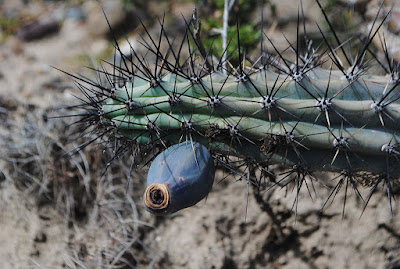Cereus aethiops is native to the north of Argentina, in the provinces of Buenos Aires, Catamarca, Córdoba, Entre Ríos, La Pampa, La Rioja, Mendoza, Rio Negro, Salta, San Juan, San Luis and Tucumán...
Cereus aethiops also called as Cereus mendory, Piptanthocereus aethiops, is a species of the genus Cereus. This species was described by Adrian Hardy Haworth in 1830.
IDENTIFY CEREUS AETHIOPS
Cereus aethiops is native to the north of Argentina, in the provinces of Buenos Aires, Catamarca, Córdoba, Entre Ríos, La Pampa, La Rioja, Mendoza, Rio Negro, Salta, San Juan, San Luis and Tucumán. It grows at an altitude of 0 to 800 m above sea level in a variety of conditions: in dry forests, in bush thickets, on lowland meadows.
It is a bushy, erect, pillarike cactus, sometimes creeping, usually very branched from the base, up to 2 m high, up to 1.5 m wide, with a blue waxy coating on young stems and with characteristic black spines, with dark bluish-green to a mauve, 1-2 m long, slightly narrowing towards the apex stem, with 5 to 8 flat, slightly tuberculate, obtuse or rounded ribs and large, often almost black, located at a distance of up to 1.5 cm from each other areoles.
This cactus blooms at night with white or pale pink, fragrant, funnel-shaped, up to 22 cm long, 12 cm in diameter flowers. The outer petals are linear-lanceolate, purple or pink, their outer side is bluish-green, the inner petals are white. Stamen filaments and pestle do not protrude beyond the corolla, stamen filaments are attached to the inner walls of a long flower tube. The fruit plum with a truncated apex, after maturation brownish-red to purple, with thick skin, smooth, with a light gray bloom, 4-6 cm long. The seeds are black.
CEREUS AETHIOPS CARE AND CULTURE
Cultural information should only be used as a guide, and should be to be adapted to suit you. Your physical location; where you grow your plants, how much time you have to devote to their care, and many other factors, will need to be taken into account. Only then can you decide on the cultural methods that best suit you and your plants.
Light:
Cereus aethiops is well tolerated by bright light. Full sun stimulates the flowering of the cactus and the formation of powerful spines.
Temperature:
This cactus is frost-resistant if they are kept in a dry state, they can tolerate a short-term frosts to -12 ° C, but it is better to avoid freezing temperatures. Good ventilation is necessary. The optimum temperature in winter is 10-12 ° C.
Substrate and growing media:
This species prefers a very loose mineral mixture for cactus, but can become too elongated if compost is too rich. This plant needs a lot of space for the roots, so it must be repotted every two years or when it grows out of pot. Good drainage is required.
Watering:
In summer the watering is moderate, but do not overwater, as the cactus is prone to decay. In winter, they need to keep dry.
Fertilizer:
Cereus aethiops needs to feed with a high potassium fertilizer in summer.
Grow from seeds:
Cactus seedlings are very fragile on the first weeks and survival depends on how they are treated on that crucial stage; out of 100 of seeds in the wild only a few survive to an adult plant to produce seeds and start the cycle again. Obtaining a high percentage of adult plants from a batch of seedlings, depends on how each collector takes care of their seedlings.
Water for seedlings is the most important item to keep them growing for first few weeks. Generally, most seedlings, which are 1 week old will die after 3 days of dryness. 2 month-old seedlings can survive for 1 week if allowed to dry. 6 month-old seedlings can survive for 2 months if allowed to dry. 1 year-old seedlings can survive for 5 months if allowed to dry.
Planting instructions for 4”pot kit: First, clean with water and chlorine plastic pot, clear cover and label and wash with fresh water. Second, the soil can be sterilized for 2 hours at 120º C in an oven or a microwave but can be used without sterilization. Third, fill the pot with soil and spray with distilled, reverse osmosis or pure rainwater to let soil flatten at the top. Fourth, place to 1/8 to 1/4 inch layer of Dyna Rock or crushed sea shell extra fine on top to cover the soil making a layer between soil and seeds. Fifth, place seeds over the Dyna Rock and fine spray water the seeds well and cover with a clearcover.

















COMMENTS